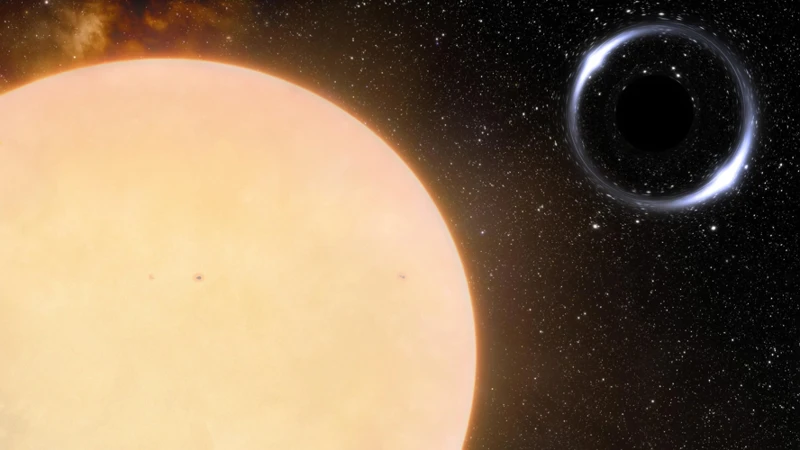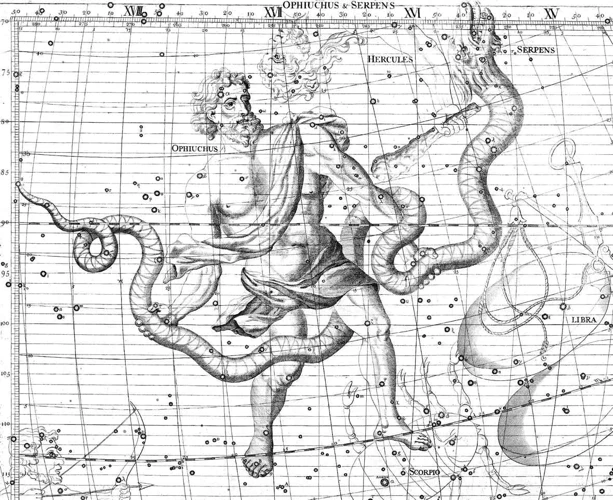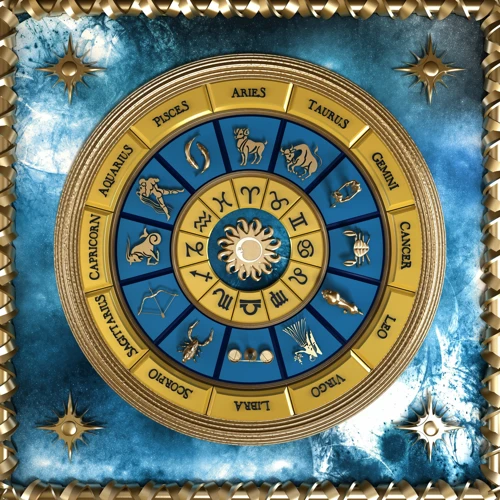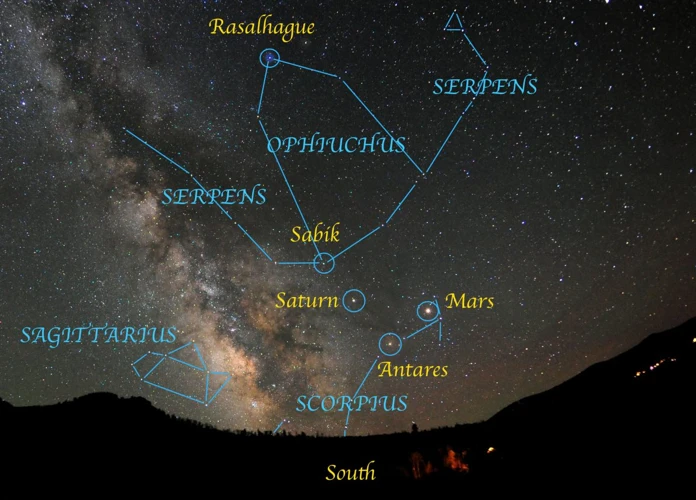The Ophiuchus Constellation is a celestial wonder that has captivated humanity for centuries. With its intricate arrangement of stars and rich mythology, Ophiuchus has become a fascinating subject of exploration and interpretation. This article delves into the folklore, legends, and scientific facts surrounding Ophiuchus, shedding light on its significance in various cultures and its impact on astrology. Join us on a journey through the cosmos as we unravel the mysteries of Ophiuchus and discover the hidden treasures it holds.
The Ophiuchus Constellation: An Overview

The Ophiuchus Constellation, also known as the Serpent Bearer, is located near the celestial equator and can be seen in both the northern and southern hemispheres. It is one of the largest constellations in the sky and is positioned between the constellations of Scorpius and Sagittarius. Ophiuchus is depicted as a man holding a serpent, symbolizing healing and wisdom. The constellation is composed of several notable stars, including Rasalhague, the brightest star in Ophiuchus. Known for its distinctive “M” shape, Ophiuchus is a prominent feature in the night sky and has intrigued astronomers and stargazers alike. Its significance in astrology is a subject of debate, as it falls along the ecliptic and is often referred to as the forgotten zodiac sign. The Ophiuchus Constellation’s reputation as a mysterious and enigmatic constellation has also captured the attention of popular culture, with references to it appearing in various forms of media. Through its rich history, scientific importance, and cultural impact, the Ophiuchus Constellation continues to fascinate and perplex those who study the wonders of the cosmos.
Folklore and Legends of Ophiuchus

The folklore and legends surrounding the Ophiuchus Constellation are steeped in mystical tales and ancient wisdom. In different cultures, Ophiuchus is often associated with the archetype of the healer and snake charmer. In Greek mythology, it is believed to represent the legendary figure of Asclepius, the son of Apollo and a skilled physician known for his ability to resurrect the dead. Asclepius’ compassionate nature and healing prowess made him highly revered among the gods and mortals alike. In other cultural interpretations, Ophiuchus symbolizes various deities and heroes known for their healing abilities and spiritual enlightenment. The prominence of serpents within the constellation further adds to its mythological significance, representing wisdom, rebirth, and transformation. Explore the cultural depth and impact of Ophiuchus through its folklore, and learn how its stories have shaped our understanding of healing, spirituality, and the cosmos.
The Healer and Snake Charmer
The Healer and Snake Charmer are iconic aspects of the Ophiuchus Constellation in various mythologies and folklore. In ancient Greek mythology, Ophiuchus is associated with Asclepius, the god of medicine and healing. Asclepius was known for his ability to resurrect the dead, symbolizing the power to restore life and bring about healing. This connection with healing is reflected in the depiction of Ophiuchus as a healer, holding a snake. The snake, which is often intertwined around the figure, is a symbol of rebirth, wisdom, and transformation. This association with snakes led to the constellation being linked to the practice of snake charming. Snake charmers were believed to possess the ability to control and communicate with serpents, representing the harmony between Ophiuchus and the serpent it holds. Throughout history, healers and physicians have looked to Ophiuchus for inspiration and guidance, seeking the wisdom and knowledge associated with this constellation. The tales of the Healer and Snake Charmer in Ophiuchus highlight the constellation’s significance in the realm of medicine and its role as a symbol of healing and transformation. [Learn more about the cultural impact of Ophiuchus here.](/ophiuchus-zodiac-cultural-impact/)
Ophiuchus in Greek Mythology
Ophiuchus holds a prominent place in Greek mythology, as it is associated with the figure of Asclepius, the Greek god of medicine and healing. According to the myth, Asclepius was the son of Apollo, the god of healing, and Coronis, a mortal woman. Asclepius possessed incredible healing powers and was known for his ability to resurrect the dead. However, his miraculous abilities aroused the jealousy of Hades, the god of the underworld, who feared that fewer souls would journey to his realm. In retaliation, Zeus struck Asclepius with a thunderbolt, ending his mortal life. To honor his accomplishments and knowledge in medicine, Zeus placed Asclepius among the stars, forming the constellation Ophiuchus. The serpent that Ophiuchus is depicted holding represents the healing staff of Asclepius, which has become a symbol of medicine in modern times. This connection to Greek mythology highlights the importance of Ophiuchus as a symbol of healing and wisdom, resonating with its reputation as a constellation of great significance. To learn more about the impact of Ophiuchus in cultural beliefs and its role in modern pop culture, visit this article.
Other Cultural Interpretations
Other cultural interpretations of the Ophiuchus Constellation exist across the globe, each adding their own unique narratives and significance to the celestial figure. In Chinese culture, Ophiuchus is associated with the deity Shennong, known as the “Divine Farmer” and the father of Chinese medicine. The constellation is seen as a symbol of healing and herbal medicine. In Native American folklore, the constellation is often linked to the Hopi people, who regard it as the guardian of the underworld and the bringer of fertility and harvest. In ancient Mayan culture, Ophiuchus is associated with the god Kukulkan, who represents rebirth and the renewal of life. These diverse interpretations highlight the transcultural appeal of the Ophiuchus Constellation and its enduring significance throughout history. It exemplifies the universal fascination with the stars and their ability to inspire and shape cultural beliefs and heritage. To learn more about the importance of the Ophiuchus Constellation, click here.
Modern Interpretations and Astrological Significance

Modern interpretations and astrological significance of the Ophiuchus Constellation have been a topic of discussion and debate in recent years. As the thirteenth sign of the zodiac, Ophiuchus challenges the traditional twelve-sign system that has been widely accepted in Western astrology. Those born under the Ophiuchus sign are said to possess characteristics such as wisdom, healing abilities, and a mysterious allure. While some astrologers argue that Ophiuchus should be included in the zodiac, others believe that it should be regarded as a sidereal sign or a constellation outside of the traditional zodiac. Regardless of its official status in astrology, Ophiuchus has gained attention and recognition among those who seek to explore alternative interpretations of personality traits and cosmic influence. Whether you consider Ophiuchus a significant addition to the zodiac or a fascinating celestial entity in its own right, its modern interpretations continue to intrigue astrology enthusiasts and spark discussions about the ever-evolving nature of the cosmos.
Ophiuchus and the Zodiac
Ophiuchus has long been a subject of interest and controversy when it comes to its relationship with the zodiac. In traditional astrology, the zodiac consists of twelve signs, each representing a specific period of time and associated with certain personality traits. However, Ophiuchus finds itself in a unique position as it lies along the ecliptic, the path the Sun appears to follow throughout the year.
Astrologically, Ophiuchus is often referred to as the “thirteenth sign” or the “forgotten sign” of the zodiac. This is because, technically speaking, it falls within the same area of the sky as the other twelve zodiac signs. Due to its proximity to the ecliptic, some argue that Ophiuchus should be recognized as an official zodiac sign, bringing the total count to thirteen.
Those who advocate for the inclusion of Ophiuchus argue that it represents individuals born between November 29th and December 17th. They believe that people born under this sign possess traits such as healing abilities, wisdom, and a desire to seek knowledge. However, it’s important to note that mainstream astrology still adheres to the twelve-sign system, and Ophiuchus is not officially recognized in most astrological interpretations.
Despite the controversy, interest in Ophiuchus and its potential influence on astrology continues to grow. Some astrologers include Ophiuchus as an additional sign in their readings, offering personalized horoscopes for those who identify with this celestial configuration. However, it’s worth mentioning that this is not universally accepted in the astrological community.
While its role in the zodiac remains a topic of debate, Ophiuchus’s inclusion challenges traditional astrological interpretations and encourages a reevaluation of the established beliefs surrounding the zodiac system. It invites us to explore new possibilities and expand our understanding of the cosmos, making it an intriguing subject of discussion for astrologers and astrology enthusiasts alike.
The Impact of Ophiuchus on Astrology
The Impact of Ophiuchus on Astrology:
1. Shift in Zodiac Dates: Ophiuchus has stirred controversy in the astrological world due to its potential impact on the zodiac dates. Traditionally, the zodiac consisted of twelve signs, each corresponding to a specific period of the year. However, with the addition of Ophiuchus, the dates of the zodiac signs could be altered, leading to a shift in the astrological calendar.
2. Personality Traits and Characteristics: Those who align themselves with the Ophiuchus zodiac sign claim to possess unique personality traits. Individuals born under Ophiuchus are said to be intuitive, ambitious, and are often natural healers. Their attributes are linked to the constellation’s association with medicine and the Serpent Bearer’s ability to bring about transformation and rejuvenation.
3. Controversy and Skepticism: The inclusion of Ophiuchus in astrology has faced mixed reception. While some astrologers embrace the addition, others remain skeptical or dismissive, arguing that the traditional twelve zodiac signs encompass a vast range of human experiences and traits. This disparity further fuels the debate surrounding the role of Ophiuchus in astrological interpretations.
4. Exploration and Personal Discovery: Despite the controversy, Ophiuchus has sparked curiosity among astrology enthusiasts, leading to a deeper exploration of its symbolism and significance. Many individuals search for their compatibility with Ophiuchus and uncover insights into their own personality and life path beyond the traditional zodiac system.
5. Integration into Personalized Horoscopes: Some astrologers have begun incorporating Ophiuchus into personalized horoscopes, recognizing its potential influence on an individual’s astrological profile. This adaptation allows for a more inclusive approach to astrology, accommodating the interests and beliefs of a wider audience.
The impact of Ophiuchus on astrology is an ongoing discussion, with proponents and skeptics offering diverse perspectives. Its inclusion challenges existing astrological frameworks and encourages individuals to explore the connections between celestial bodies and personal identity. Whether seen as an essential addition or an astrological anomaly, Ophiuchus continues to intrigue and fascinate those seeking a deeper understanding of themselves and the universe.
Scientific Facts and Explorations
Scientific research and exploration have shed light on fascinating aspects of the Ophiuchus Constellation. One significant milestone was its discovery by the Greek astronomer Ptolemy in the 2nd century. Today, astronomers continue to study Ophiuchus and its noteworthy features. Within the constellation, there are several notable objects, such as the Ophiuchus Molecular Cloud Complex, which is a region of intense star formation. Additionally, the Barnard’s Star, one of the nearest stars to the Sun, is located in Ophiuchus. Scientists also observe the Ophiuchus Constellation to study binary star systems, black holes, and exoplanets. The future of Ophiuchus in astronomy holds exciting possibilities, as new telescopes and technologies enable us to delve deeper into the mysteries of this captivating constellation. From its historical discovery to ongoing scientific investigations, the Ophiuchus Constellation continues to offer a wealth of knowledge and fascination to astronomers and space enthusiasts alike.
The Discovery of Ophiuchus
The discovery of the Ophiuchus constellation dates back to ancient times, with its origins found in early Greek and Babylonian astronomy. However, it wasn’t until the 17th century that Ophiuchus was officially recognized and cataloged by astronomers. It was included in the 48 constellations listed by the astronomer Johannes Hevelius in his star atlas, Uranographia. Ophiuchus, with its distinct shape and prominent stars, caught the attention of astronomers who were mapping the night sky. Over the centuries, many astronomers have observed and studied the constellation, contributing to our understanding of its features and significance. Through their meticulous observations and recording of celestial objects, astronomers have deepened our knowledge of the Ophiuchus constellation and its place in the vast expanse of the universe. As technology and exploration continue to advance, there is still much more to uncover about this intriguing constellation and its many wonders.
Noteworthy Features Within the Constellation
Noteworthy Features Within the Constellation
1. Rasalhague: One of the most prominent stars in Ophiuchus is Rasalhague, also known as Alpha Ophiuchi. It is a binary star system located approximately 47 light-years away from Earth. Rasalhague is notable for its bluish-white color and ranks as the brightest star within the constellation.
2. Barnard’s Star: Another significant star within Ophiuchus is Barnard’s Star. Although it is not visible to the naked eye, it holds importance in astronomical research. This red dwarf star is one of the closest-known stars to our solar system, located just over six light-years away.
3. Globular Cluster M14: Ophiuchus houses the impressive globular cluster M14. This cluster is a tightly packed group of stars that orbit around a common center, forming a spherical shape. M14 is notable for its dense core and a diverse population of stars.
4. Dark Nebulae: Ophiuchus is also home to several dark nebulae, including the Snake Nebula (Barnard 72) and the Pipe Nebula. These dark clouds of gas and dust obstruct the light from stars behind them, creating intriguing silhouettes against the background of bright stars.
5. Kepler’s Supernova Remnant: In 1604, a supernova explosion was observed within Ophiuchus, now known as Kepler’s Supernova Remnant. This stellar explosion, which occurred in the constellation’s southeastern part, created an expanding shell of gas and dust. Today, it remains a captivating object for astronomers studying the aftermath of supernova events.
These noteworthy features within the Ophiuchus Constellation contribute to its allure and scientific significance. Whether it’s the dazzling stars, fascinating clusters, or intriguing remnants of astronomical events, Ophiuchus continues to captivate sky watchers and astronomers alike with its celestial wonders.
The Future of Ophiuchus in Astronomy
The future of Ophiuchus in astronomy holds both excitement and uncertainty. As technology advances, astronomers are gaining more sophisticated tools to observe and study celestial objects, including the Ophiuchus Constellation. With the help of powerful telescopes and space probes, scientists are uncovering new details about the stars, galaxies, and other cosmic phenomena within Ophiuchus. This ongoing exploration is expected to unveil a deeper understanding of the constellation’s formation, evolution, and role in the universe. Additionally, as our knowledge expands, we may discover previously unknown features or objects within Ophiuchus, further expanding our understanding of the cosmos. However, the future of Ophiuchus in astronomy also faces challenges. Light pollution and urban development can hinder optimal visibility of the night sky, making it harder to observe and study constellations like Ophiuchus. Additionally, ongoing budget constraints and competition for resources may impact the funding and support required for continued research and exploration of the Ophiuchus Constellation. Nevertheless, with the passion and dedication of astronomers and the constant advancements in technology, the future of Ophiuchus in astronomy remains promising, holding the potential for groundbreaking discoveries and a deeper appreciation of the mysteries of the universe.
Conclusion
In conclusion, the Ophiuchus Constellation is a captivating celestial entity that has enthralled humanity for centuries. Its rich mythology, scientific significance, and astrological implications make it a subject of both wonder and debate. The constellation’s depiction as the Healer and Snake Charmer in folklore and its role in Greek mythology showcase the diverse interpretations and cultural significance of Ophiuchus. In modern times, Ophiuchus has sparked discussions and debates in the realm of astrology, challenging the traditional zodiac system with its potential inclusion as a thirteenth sign. The scientific exploration of Ophiuchus has brought forth fascinating discoveries, such as its notable stars like Rasalhague, as well as ongoing research to uncover more about its mysteries. Whether viewed through the lens of folklore, astrology, or scientific exploration, the Ophiuchus Constellation continues to captivate and fascinate astronomers, stargazers, and enthusiasts around the world. As we peer into the depths of the cosmos, let the enigmatic allure of Ophiuchus remind us of the eternal fascination that lies above.
Frequently Asked Questions
1. What does the name “Ophiuchus” mean?
The name “Ophiuchus” originates from the Greek word “ophis,” meaning serpent, and “kheir,” meaning hand or holder. Thus, Ophiuchus is often referred to as the Serpent Bearer.
2. How can I locate the Ophiuchus Constellation in the night sky?
To locate the Ophiuchus Constellation, look for it between the constellations of Scorpius and Sagittarius. It lies along the celestial equator and can be visible in both the northern and southern hemispheres.
3. What is the significance of Rasalhague in Ophiuchus?
Rasalhague, also known as Alpha Ophiuchi, is the brightest star in the Ophiuchus Constellation. It is an important point of reference for astronomers and stargazers observing the constellation.
4. Is Ophiuchus a part of the zodiac?
Ophiuchus is often referred to as the forgotten zodiac sign. While it falls along the ecliptic, the path taken by the Sun, Moon, and planets, Ophiuchus is not traditionally considered one of the twelve zodiac signs.
5. What is the mythology behind Ophiuchus being depicted as a man holding a serpent?
In Greek mythology, Ophiuchus is associated with the story of Asclepius, the son of Apollo and the god of medicine and healing. Asclepius was said to possess the ability to resurrect the dead and was often depicted with a serpent, symbolizing rebirth and rejuvenation.
6. Are there any other cultural interpretations of Ophiuchus?
Yes, besides Greek mythology, other cultures have their own interpretations of Ophiuchus. For example, in ancient Egyptian astronomy, Ophiuchus was associated with Imhotep, a healer and architect who was deified after his death.
7. How has Ophiuchus influenced modern astrology?
The inclusion of Ophiuchus in astrology is a subject of debate. Some astrologers argue that it should be recognized as the thirteenth zodiac sign, while others maintain the traditional twelve-sign system. Its impact on astrology is complex and varies among different astrological practices.
8. What notable features can be found within the Ophiuchus Constellation?
Aside from Rasalhague, the Ophiuchus Constellation features a number of interesting objects such as globular clusters, nebulas, and binary star systems. These celestial phenomena contribute to the constellation’s beauty and scientific significance.
9. How was the Ophiuchus Constellation discovered?
The exact origin of the discovery of the Ophiuchus Constellation is unclear. The constellation has been recognized and named since ancient times, with mentions in Greek, Babylonian, and Egyptian astronomy.
10. What does the future hold for Ophiuchus in the field of astronomy?
Ophiuchus will continue to be a subject of study and exploration in the field of astronomy. As technology advances, scientists hope to unravel more mysteries within the constellation, further enhancing our understanding of the universe.








